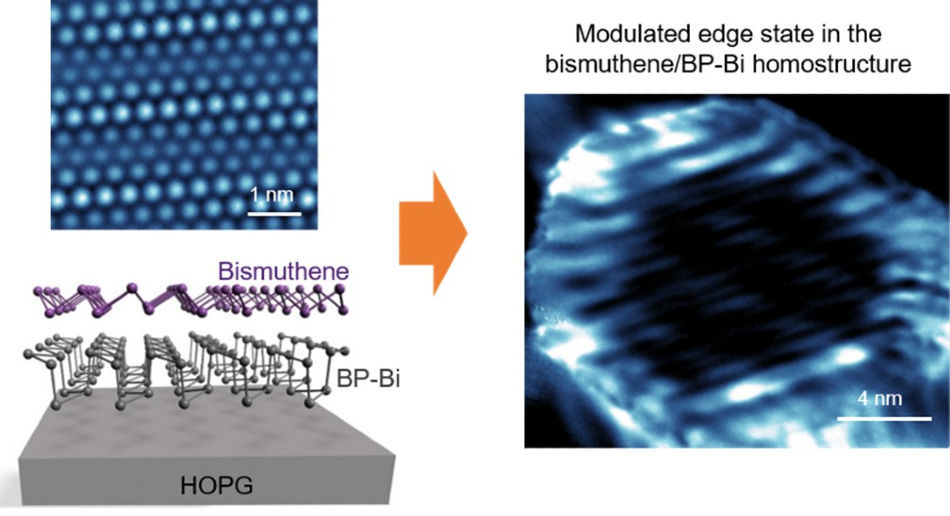Jun 5 2020
Physicists at the National University of Singapore (NUS) have devised a new technique to develop and adjust the topological edge states in two-dimensional (2D) topological insulators (TIs) for prospective spintronic device applications.
 Figure shows the measured atomic surface structure using non-contact atomic force microscopy (upper left), and the modulated edge state in a homostructure island (right); the corresponding structure model is illustrated (lower left). Image Credit: National University of Singapore.
Figure shows the measured atomic surface structure using non-contact atomic force microscopy (upper left), and the modulated edge state in a homostructure island (right); the corresponding structure model is illustrated (lower left). Image Credit: National University of Singapore.
TIs can be described as materials that act as an insulator from their interior, but include conducting states on their surface, which implies that electrons can move only along the material’s surface. In the same way, a 2D TI acts as an insulating 2D material but contains electrons that are allowed to move along its edges.
2D TIs are potential candidates for spin electronics and devices with negligible/minimal energy dissipation, like ultra-low energy electronic devices and quantum computers. But it is highly difficult to fabricate robust TIs and to reliably tune their topological states.
Specifically, 2D bismuthene, or bismuth monolayer that has a honeycomb atomic structure, has been estimated to be the ideal candidate for a 2D TI. However, researchers have not yet achieved the fabrication of free-standing modes in a single layer bismuthene, and how the substrate impacts the topological states is still unclear.
Led by Prof Andrew WEE from the Department of Physics, NUS, a team of researchers has successfully developed a bismuthene homostructure through molecular beam epitaxy (MBE). This low-temperature deposition technique enables growing a single layer of bismuthene on a single layer of black-phosphorus-like bismuth layer (BP-Bi) to create a vertical homostructure with various rotation angles between both the layers.
Due to the different arrangement of atoms in both the layers of the homostructure, it is observed that the interlayer interaction between the two layers is largely restricted and periodically modified. This leads to a virtually free-standing bismuthene monolayer exhibiting tunable topological edge states.
Moiré patterns, which are large area interference patterns, form when one periodic lattice is overlaid on another similar lattice, essentially at a small relative rotation angle. This innovative technique of using the moiré pattern created by rotating two 2D materials with respect to each other can likely be used to deliberately control the performance of devices.
Unlike 3D semiconductors where the electronic properties are tuned by the introduction of doping atoms, the properties of atomically thin 2D materials are easily modified by dopant atoms. Hence, the observation of topological state modulation by a bismuthene homostructure offers a damage-free method of controlling the electronic states in 2D TI devices.
Dr GOU Jian, Research Fellow, National University of Singapore
“The exciting field of twistronics+ has recently been demonstrated in graphene, and this work on bismuthene reveals its beauty in uncovering the topological edge states in a 2D material,” noted Prof Wee.
The researchers intend to further study such innovative moiré patterns, with the hope of achieving more robust tuning of the electronic states in 2D TIs.
Journal Reference:
Gou, J., et al. (2020) The effect of moiré superstructures on topological edge states in twisted bismuthene homojunctions. Science Advances. doi.org/10.1126/sciadv.aba2773.